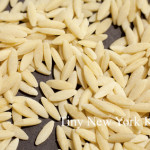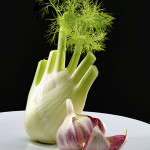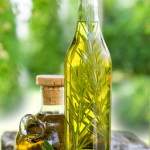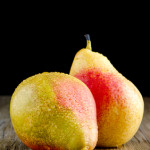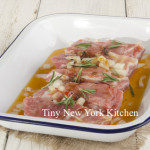The end of summer is fresh produce heaven, which includes delicious vine ripened tomatoes. What do you do when you have a tomato abundance?
Here are some tips for making the most of the end of summer tomatoes.
Sliced: Incorporate into sandwiches or add to basil and mozzarella for a Caprese Salad.
Chopped: You only need a few chopped heirloom tomatoes, mozzarella, chopped basil, and olive oil for a colorful no-cook pasta sauce.
Puréed: There’s nothing like an icy cold gazpacho on a warm day.
Salsa: Fresh salsa is a must have condiment for grilled steaks or shrimp, brown rice and beans, scrambled eggs, and of course, chips.
Grilled: Toss cherry tomatoes with olive oil, garlic, and herbs. Then cook in a grill basket until charred. Top fish, chicken, pasta, and charred slices of bread.
Stored: Keep tomatoes at room temperature until ripe and then use within a day or two. Don’t put them in the refrigerator as it affects their flavor and texture.
Preserved: Roasted, dehydrated, or stewed – savor the season by saving a taste of summer for later.
“Work With What You Got!”
© Victoria Hart Glavin Tiny New York Kitchen © 2017 All Rights Reserved
From Concord to Emperor, there are so many delicious grape varieties available.
Whether tossed in a salad, baked into a dessert, or straight off the vine, these bite-size globes are packed with flavor.
Bursting with fiber, vitamin C, and loads of antioxidants, this fruit packs a nutritional punch as big as flavor. Grapes make an ideal portable snack in less than 100 calories per cup.
Look for firm grapes that are brightly colored and securely attached to their stems. Avoid bundles with wrinkled, dull skin or packages that have a lot of fruit floating at the bottom of the bag. When all else fails, try one.
Although there are thousands of varieties of grapes, the most popular are Thompson and Emperor seedless. Thompson grapes are sweet and crisp with vibrant green skin, amazing for snacking. Emperor red grapes have a sweet and tart flavor and are super juicy, making them great for baking.
Emperor or Flame: With their sweet flavor and long shelf life, these large seedless grapes are one of the most popular varieties.
Thompson Green: In America, 90% of these classic green grapes are produced in California. They are used for snacking, making wine, and raisins.
Concord: Created in Concord, Massachusetts, these grapes are known for their thick, blush skin and sweet candy-like flavor.
Freeze Them: Pick grapes off the vine and place them in a resealable plastic bag. Freeze overnight for a healthy, frosty treat.
Bake Them: To make raisins at home, cook grapes for 30 seconds in boiling water and place in a bowl of ice water. Preheat the oven to 170 degrees and place grapes on a parchment paper lined baking sheet. Bake until they have dried out completely. Toss grapes halfway through to prevent sticking.
Blend Them: Blend grapes with a bit of water and pour through a fine mesh strainer for a fresh glass of grape juice.
“Work With What You Got!”
© Victoria Hart Glavin Tiny New York Kitchen © 2017 All Rights Reserved
Orzo is the Italian word for barley; however, orzo is not made from barley at all, but rather from semolina, which is a course ground flour made from durum wheat. With its shape reminiscent of slivered almonds, orzo cooks up in about half the time of rice, making it a speedy standby to have on hand to add heartiness to meals.
Just bring 3 quarts of lightly salted water to a boil. Add 8 ounces ( 1 1/2 cups) dried orzo and boil about 10 minutes until it has a firm, chewy texture. Stir occasionally to prevent it from sticking together. Drain orzo in colander and serve immediately.
Rinse orzo only if it will be baked or served cold in a salad. Otherwise, do not rinse as rinsing removes a light coating of starch that helps sauces and seasonings cling to the pasta.
For the best texture and flavor serve orzo immediately after cooking. If your orzo gets done before the rest of the meal, you can keep it warm by returning the cooked drained pasta to the warm cooking pan. Stir in a little butter or olive oil to prevent it from sticking together. Cover the pasta with a lid and let it stand no more than 14 minutes.
“Work With What You Got!”
© Victoria Hart Glavin Tiny New York Kitchen © 2017 All Rights Reserved
Fennel is a flowering plant species that is in the carrot family. Indigenous to the Mediterranean, fennel is now grown in many parts of the world with dry soil, near seacoasts, and on riverbanks.
Fennel is highly aromatic and flavorful with culinary and medicinal uses. Florence Fennel (or Finocchio) is used as a vegetable and is one of the three main herbs used in preparation of absinthe, an alcoholic mixture that originated as a medicinal elixir in Switzerland and became, by the late 19th century, a popular alcoholic drink in France and other countries.
Fennel bulb, foliage, and seeds are used in many culinary traditions around the world. The small flowers of wild fennel (fennel pollen) are the most potent form of fennel and are also the most expensive. Dried fennel seeds are an aromatic, anise-flavored spice that are brown or green in color when fresh, and slowly turn a dull grey as the seeds age. Green seeds are the best for cooking. Fennel seeds are sometimes confused with anise, which are similar in taste and appearance, though smaller. Fennel seeds are the primary flavor component in Italian sausage.
Fennel leaves are delicately flavored and are similar, in shape, to those of dill. The bulb itself is a crisp vegetable that can be sautéed, stewed, braised, grilled, or eaten raw. Young tender leaves are used for garnishes, as a salad to add flavor to salads, to flavor sauces, in soups, and fish sauce. Fennel leaves are used in some parts of India as leafy green vegetables either by themselves or mixed with other vegetables. In Syria and Lebanon young fennel leaves are used to make a special kind of egg omelet (with onions and flour) called ijjeh.
Florence fennel is a key ingredient in some German and Italian salads that are often tossed with chicory and avocado. It can be braised and served as a warm side dish. It can also be blanched, marinated, or cooked in risotto. In Spain the stems of the fennel plant are used in the preparation of pickled eggplant called berenjenas de almagro. In Israel fennel salad is made of chopped fennel bulbs flavored with salt, black pepper, parsley, olive oil, and sometimes sumac.
“Work With What You Got!”
© Victoria Hart Glavin Tiny New York Kitchen © 2017 All Rights Reserved
One of the best ways to preserve the abundance of fresh herbs from your garden is by making flavored oils. Herb oils can be enjoyed so many ways – drizzled over salads, vegetables, pastas, sandwiches, or grilled items, hot or cold or at room temperature. Not only are they flavorful, but they also add dramatic color when drizzled on plates. If you want to add more flavor add half a clove of smashed garlic and 1/2 teaspoon crushed red pepper to the blender with the other ingredients, which makes a great dipping oil for chunks of rustic bread.
“Work With What You Got!”
© Victoria Hart Glavin Tiny New York Kitchen © 2017 All Rights Reserved
I’ve been making the most of cherry season these days and sometimes have to get a bit inventive to use them to the fullest. Here are some ways to make the most of beautiful summer cherries.
Breakfast: Make quinoa and top with almond milk and cherries for a nourishing hot cereal bowl.
Lunch: Pick your favorite whole grain to make a salad with cherries, arugula, almonds, and tarragon.
Snacks: Blend almond milk, creamy almond butter, and cherries to make a delicious smoothie.
Dinner: Grill salmon and serve with couscous combined with cherries, green onions, and toasted almonds.
Dessert: Make a cherry crisp. You may want to throw in some dates or figs to give it a little extra heartiness.
Preserve: Make cherry jam, cherry syrup, or pickled cherries.
“Work With What You Got!”
© Victoria Hart Glavin Tiny New York Kitchen © 2017 All Rights Reserved
Probably the first vegetable to be cultivated by man, ancient peas and beans have been found in settlements from the late Stone Age onwards (nearly 8,000 years ago). They are a highly nutritious vegetable, containing essential carbohydrates and proteins, as well as useful supplies of vitamins and minerals. They were particularly valuable to ancient man as they could be dried and stored, which meant that food was available throughout the year.
Garden Peas: These are one of the delights of summer, although they are one of those vegetables that are best when absolutely fresh. Pick your own (if you don’t grow them yourself) is the best way to enjoy peas at their best. There are many varieties of peas, some of which can be eaten whole, including the pod. Peas are one of the few vegetables that taste almost as good when frozen. Because freezing takes place soon after picking, frozen peas often have a higher nutritional content than fresh, and are available all year round.
Mangetouts: These are eaten whole and are valued for their pods, rather than the peas, which never mature. Mangetouts have a delicate, sweet flavor. To prepare, young, freshly picked mangetouts simply need to be topped, tailed, and washed. They should be cooked only briefly to retain their delicate, mild flavor and crisp bite. They can be blanched or stir-fried and are also good served raw in salads.
Petits Pois: These are not, as you might expect, immature peas, but are a dwarf variety. They are wonderfully tender and have a sweet, delicate flavor. Gardeners grow their own, but petits pois are not widely available fresh in the shops as they are mainly grown commercially for canning or for freezing.
Snow Peas/Sugar Peas/Sugar Snap Peas: These have the distinct fresh flavor of raw peas and are plumper and have more “snap” than mangetouts. They are delicious added raw to salads. They are also good steamed or boiled, but should only be cooked for about 1 minute or they will lose their wonderful flavor and texture.
Buying And Storing: Only buy really fresh peas. If they are old they are bound to be disappointing. In top condition, the pods are bright green and lively looking. The more withered the pod, the longer ago they were picked. Use fresh peas as soon a possible.
www.tinynewyorkkitchen.com
“Work With What You Got!”
© Victoria Hart Glavin Tiny New York Kitchen © 2017 All Rights Reserved
There are almost as many varieties of pears as there are apples, but only a dozen or so are readily available in stores. Pears are related to apples, but are much more fragile and are more often eaten raw than cooked. They have fine white granular flesh and a core containing the pips (seeds). Most pears are wider at the bottom than the top, but some are apple-shaped, while calabash pears have an elongated neck, like a gourd. Pears tend to be less vividly colored than apples, usually varying from bronze to gold, green or yellow, although there are also some red-bushed varieties such as Red Williams and Forelle.
Anjou: These large pears have greenish yellow skin with small brown spots. The flesh is juicy and sweet. Suitable for eating and cooking.
Beurre Superfin: Large, with a tough golden green, russet skin, this is the perfect eating pear. Its flesh is sweet and juicy and it is less grainy than other pears.
Conference: First cultivated in the English country of Berkshire in 1770, these long, conical pears have remained a favorite because they keep so well. The yellowish-green skin with extensive russet turns more yellow when the pears are mature. The granular flesh is tender, sweet and juicy. Conference pears are excellent for eating and cooking.
Comice: This large, roundish pear is one of the finest of all pears, with creamy white, melting, very juicy flesh and a sweet, aromatic flavor. The thick, yellowish-green skin is covered with speckles and patches of russet. Comice are best eaten raw and they are delicious served with Camembert or Brie cheese.
Forelle: This beautiful golden pear has a dark red flush on one side. The grainy flesh is crisp, with a fresh flavor. Eaten raw, it goes particularly well with cheese, but is at its best when cooked.
Laxton’s Foremost: Yellow-skinned and lightly russet, this is one of the largest pears. Its creamy colored flesh is very juicy and granular. It does not keep well and, as it turns brown from the inside out, there may be no external signs that the fruit is past its best.
Packham’s Triumph: The first successful Australian pear was produced by Charles Packham in 1896 and remains a favorite. Slow-ripening, it is a largish dessert pear, with a smooth green, lightly russet skin that changes to yellow as it ripens. The soft white flesh is succulent and sweet, with a touch of acidity.
Red Williams: These pears have shiny, speckled skins, at first green with a red blush, turning to yellow flushed with red. The flesh is sweet and juicy.
Bartlett/Williams Bon Chrétien: These irregularly shaped pears are generally swollen on one side of the stalk. The speckled skin is golden yellow with russet patches and sometimes a red tinge. The delicious tender flesh is creamy-white and very juicy, and the flavor is sweet and slightly musky. Bartletts are suitable for cooking and eating, but unfortunately these superb pears do not keep well.
Winter Nelis: This roundish medium-size pear has thick, but tender greenish-yellow skin with cinnamon-brown russet and sometimes a pink flush. The creamy-white flesh is soft and very juicy, and the flavor is sweet. These pears can be cooked or eaten raw.
Perry Pears: With the demise of the most famous of the sparkling alcoholic pear drinks, perry pears have largely fallen into disfavor. A few small producers still press perry pears into juice, wine or “champagne” perry, but although there are still about 300 known varieties, you will never find these in stores. Perry pears are smaller than their dessert counterparts. Although they look delicious, they contain large quantities of tannin and taste bitter and astringent, whether raw or cooked.
Asian/Nashi Pears: There are many varieties of Asian pears, but their characteristics are very similar. They are round rather than a pear shape, the fruits have a golden brown russet skin and they have very crisp, white juicy flesh. The crunchy texture resembles that of an apple, but is more granular. It would be a shame to spoil the crisp texture by cooking. Asian pears are best eaten straight from the refrigerator, to be enjoyed as a “drink of the stalk”. They also make an excellent addition to fruit salads or savory winter salads.
Tientsin: These Asian pears from China and Korea are very similar to Asian Nashi pears in taste and texture. They are available when Asian pears are out of season. They look rather like elongated apples, tapering gently at both ends. The skin is pale yellow, slightly speckled with patches of light brown. The pure white flesh is exceptionally juicy and crunchy.
Hosui: These pears have much the same crunch and juiciness of the Tientsin pears, but look more like apples, with green-brown mottled flesh that tastes like a cross between an apple and an unripe pear.
Buying and Storing: Always buy pears when in perfect condition, as they deteriorate quickly. Once past their best, they become wooly and squashy and unpleasant. Test for ripeness by pressing gently; the fruit should give a little, but still be quite firm. Once ripe, eat within a couple of days. They can be kept at the bottom of the refrigerator for a few days. Store unripened pears at room temperature, where they will ripen in two or three days.
Preparing and Cooking: The majority of pears are eaten raw, by themselves or with a robust cheese such a Stilton or Roquefort. Pears Savarin, halved fruit filled with Roquefort mashed with a little butter are served chilled with double (heavy) cream and paprika, is a popular appetizer. Pears also make a good addition to winter salads. Whether or not to peel pears before eating raw is a matter of preference, but they should always be peeled before cooking. Pears discolor quickly once they are peeled, so rub the cut surface with lemon juice or place in a bowl of water acidulated with lemon juice. If the recipe involves cooking the pears in wine or sugar syrup, the fruit can be put directly into these to prevent them turning brown.
Most varieties of pears are suitable for cooking, but some are specifically designated cooking pears, although commercial production of these is now decreasing. If appearance is important, choose even-size, classic pear-shaped pears such as Comice, Conference or Bartlett. For whole poached pears, simply peel with a stainless steel vegetable peeler, leaving the stalk on. Use an apple corer to core the pears if you want to stuff them with nuts or dried fruit. Poach in port or red wine spiced with cinnamon, cloves and thinly pared lemon rind, or in a vanilla-flavored syrup. For sautéed or grilled (broiled) pears, peel and quarter the fruit and scoop out the cores with a melon baller. Sauté over a low heat in unsalted butter or grill (broil), turning once, watching very closely to avoid the fruit scorching.
Pears can be used in a wide variety of desserts, including tarts, mousses, soufflés, sorbets, and ice creams. They are also delicious grated into tea breads. Pears go particularly well with nuts, especially walnuts and almonds, in both sweet tarts and savory winter salads.
Like apples, pears complement game, particularly duck and hare, while venison garnished with pears is a German specialty. For additional luxury, the pears may be cooked in pear brandy, also known as Williamine, or pear liqueur. Pears can also be roasted with small game birds and then rubbed through a sieve and served as a sauce. A slightly more unusual, but delicious combination is lamb and pears, slow cooked in a casserole. Pears also feature in soups, most famously with watercress and also with garden peas.
Fruit vinegars have come back into fashion and steeping pears in vinegar to flavor it has a long history in country and farmhouse cooking. The vinegar is a rich golden color. It can be used in salad dressings, as part of a basting mixture when roasting rich meats, especially duck, or for deglazing the cooking juices after pan-frying liver or duck to make a sauce. Pear chutney is also a traditional rural favorite, not least because you can use hard, windfall pears that would otherwise have to be thrown away. Pears can also be steeped in brandy for several weeks to make a liqueur for drinking after dinner. A more modern variation of this is to steep the fruit in vodka.
“Work With What You Got!”
© Victoria Hart Glavin Tiny New York Kitchen © 2017 All Rights Reserved
It’s so easy, but takes a tad bit of planning. Just pop meat in a heavy-duty resealable bag with your favorite marinade in the morning, refrigerate, and later in the day all you have to do is throw flavorful meat on the grill. You’ll be so impressed with yourself that you’ll feel like giving yourself a gold star! Make sure to place the bag in a bowl in the fridge to be safe. Sometimes, when I’m particularly crunched for time, I use classic Italian dressing as my go-to marinade.
Five Things To Marinate In Classic Italian Dressing
Flank Steak
Chicken Breasts
Butterflied Leg Of Lamb
Boneless Beef Short Ribs
Most Anything On A Skewer
“Work With What You Got!”
© Victoria Hart Glavin Tiny New York Kitchen © 2017 All Rights Reserved



